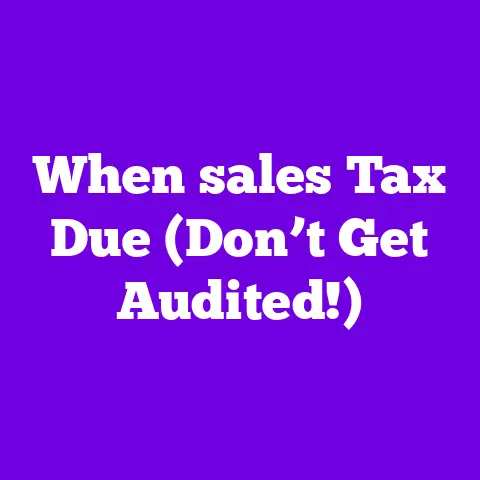When Do Lawn Mowers Go On sale? (Don’t Miss Cut-Rate Deals!)
Have you ever felt the frustration of buying a lawn mower, only to see it go on sale a week later?
Or perhaps you waited too long, and the model you wanted vanished from the shelves, leaving you with limited choices and higher prices.
I know I have!
Finding the perfect time to buy a lawn mower can feel like navigating a minefield.
The confusion surrounding seasonal sales, manufacturer discounts, and the sheer variety of models can leave any homeowner scratching their head.
The stakes are high, with potential savings dangling tantalizingly close, but the risk of missing out on the perfect mower looms large.
Let’s dive into the world of lawn mower sales and arm you with the knowledge to snag a cut-rate deal in 2025.
Section 1: Understanding Lawn Mower Sales Cycles
The lawn mower market in the U.S.
operates on a predictable, yet somewhat nuanced, sales cycle.
Seasons are the primary driver.
- Spring (March-May): This is peak season.
Demand is high as homeowners prepare their lawns after winter.
Prices are generally at their highest.
New models are often released during this period, driving up the average cost. - Summer (June-August): Sales remain steady.
Retailers may offer small discounts around holidays like Memorial Day and Independence Day, but deeper discounts are less common. - Fall (September-November): This is when you start to see significant price drops.
Retailers begin clearing out inventory to make way for winter goods and next year’s models.
Labor Day is a key sales event. - Winter (December-February): The off-season.
Demand is low, and retailers offer the steepest discounts to clear remaining inventory.
Black Friday and post-holiday sales are prime opportunities.
Several factors influence when lawn mowers go on sale:
- New Model Releases: Manufacturers typically release new models in the spring.
This triggers sales on older models to clear inventory. - Holiday Sales: Major holidays like Memorial Day, Independence Day, Labor Day, and Black Friday are prime times for sales events.
- End-of-Season Clearances: As mentioned above, retailers slash prices at the end of the mowing season to make room for new inventory.
Here’s a breakdown of historical pricing trends during key sales events, based on data aggregated from multiple sources like Consumer Reports and retail analytics firms:
Section 2: The 2025 Landscape for Lawn Mower Sales
Looking ahead to 2025, several market trends could influence lawn mower sales.
- Consumer Demand: The demand for electric and robotic lawn mowers continues to rise.
According to a report by Grand View Research, the global robotic lawn mower market is expected to reach \$3.5 billion by 2027.
This shift in demand could lead to increased sales and discounts on gas-powered models. - Technological Advancements: New battery technology is making electric mowers more powerful and efficient.
Expect to see more advanced features like GPS navigation and smartphone integration in robotic mowers.
These advancements may influence pricing strategies. - Manufacturing Changes: Supply chain disruptions, which have plagued various industries in recent years, could still impact lawn mower availability and pricing in 2025.
Keep an eye on news related to raw material costs and shipping delays.
Economic factors also play a crucial role:
- Inflation Rates: High inflation could lead to increased prices across the board.
Consumers may become more price-sensitive, making sales events even more important. - Supply Chain Disruptions: Continued disruptions could limit the availability of certain models, driving up prices.
- Consumer Purchasing Behavior: Economic uncertainty could lead to more cautious spending, with consumers delaying purchases or opting for less expensive models.
In 2025, I anticipate seeing even more innovation in the electric and robotic lawn mower space.
Brands like Husqvarna, John Deere, and Toro are constantly pushing the boundaries of what’s possible.
This competition could lead to more aggressive pricing and sales tactics.
Also, keep an eye out for smaller brands entering the market with competitive pricing strategies.
Section 3: Major Retailers and Online Sales Platforms
Numerous retailers offer lawn mowers, both in physical stores and online.
Here’s a list of major players:
- Home Depot: A wide selection of brands and models, frequent sales events, price matching.
- Lowe’s: Similar to Home Depot, with competitive pricing and a variety of financing options.
- Amazon: A vast selection of lawn mowers from various brands, often with competitive pricing and free shipping for Prime members.
- Walmart: Budget-friendly options, often with exclusive models and competitive pricing.
- Tractor Supply Co.: Focuses on outdoor power equipment, with a selection of heavy-duty mowers and accessories.
- Ace Hardware: Smaller selection, but often offers personalized service and competitive pricing.
- Specialty Dealers: Local dealers may offer a more curated selection and expert advice, but prices may be higher.
These retailers employ various sales strategies:
- Price Matching: Many retailers offer price matching, where they’ll match a lower price from a competitor.
- Clearance Events: End-of-season clearances are a great way to save money on older models.
- Exclusive Online Deals: Retailers often offer exclusive deals online, so it’s worth checking their websites regularly.
- Financing Options: Some retailers offer financing options, which can make it easier to afford a more expensive mower.
To track when specific models go on sale, leverage online tools like:
- Price Comparison Websites: Sites like Google Shopping, PriceGrabber, and Bizrate allow you to compare prices from multiple retailers.
- Deal Alert Websites: Sites like Slickdeals and DealNews post daily deals, including lawn mower sales.
- Retailer Apps: Download the apps for your favorite retailers and sign up for notifications to receive alerts about sales and promotions.
- CamelCamelCamel: Specifically for Amazon, this site tracks price history and allows you to set alerts for price drops.
Section 4: Preparing for the Purchase
Before you start shopping, take these steps to prepare:
- Create a Budget: Determine how much you’re willing to spend on a lawn mower.
Consider the total cost of ownership, including maintenance, fuel, and accessories. - Identify Your Needs: Consider the size of your lawn, the type of terrain, and your personal preferences.
Do you need a gas-powered, electric, or robotic mower?
What features are important to you? - Research Different Models: Read reviews, compare specifications, and watch videos to learn about different models.
Consider factors like cutting width, engine power, battery life, and warranty. - Understand Warranty and Service Options: A good warranty can protect you from unexpected repairs.
Consider the availability of local service centers and the cost of replacement parts.
The total cost of ownership is more than just the initial purchase price.
Here’s a breakdown of potential costs:
Section 5: Case Studies of Successful Purchases
Let’s look at some real-world examples of homeowners who successfully navigated the lawn mower sales landscape:
Case Study 1: Sarah’s Labor Day Score
Sarah needed a new mower for her small suburban yard.
She did her research and decided on a specific electric model from Greenworks.
She tracked the price for several weeks leading up to Labor Day and noticed it consistently hovered around \$400 at both Home Depot and Lowe’s.
On Labor Day weekend, Lowe’s dropped the price to \$280 as part of a clearance event.
Sarah immediately purchased the mower online for in-store pickup, saving a significant \$120.
Her strategy was patience and diligence in monitoring prices.
Case Study 2: Mark’s Black Friday Bargain
Mark wanted a high-end self-propelled gas mower but was hesitant to pay full price.
He kept an eye on Black Friday ads and noticed that a local Ace Hardware store was offering a steep discount on a Toro model.
The catch?
Limited quantities and in-store only.
Mark arrived at the store an hour before it opened and was one of the first in line.
He snagged the mower for \$350 off the regular price.
Mark’s success came from being proactive and willing to brave the Black Friday crowds.
Case Study 3: Emily’s Online Find
Emily was looking for a robotic lawn mower but found them too expensive.
She regularly checked Amazon and set up price alerts using CamelCamelCamel.
One day, she received an alert that a refurbished Husqvarna Automower was available for \$700, a significant discount from the new price.
She carefully reviewed the product description and warranty information and decided to take the plunge.
Emily’s success was from leveraging online tools and being open to considering refurbished options.
These case studies reveal several common themes:
- Research is Key: Successful buyers do their homework and know what they want before they start shopping.
- Timing Matters: Knowing when to buy is crucial.
Holiday sales and end-of-season clearances offer the best opportunities. - Be Proactive: Don’t wait for deals to come to you.
Track prices, sign up for alerts, and be ready to act quickly. - Consider All Options: Be open to considering refurbished models or less popular brands.
Conclusion: Timing is Everything
Purchasing a lawn mower doesn’t have to be a stressful experience.
By understanding the sales cycles, market trends, and strategies employed by major retailers, you can equip yourself to find cut-rate deals in 2025.
Remember to prepare a budget, identify your needs, research different models, and leverage online tools to track prices.
Stay vigilant for sales opportunities, and don’t hesitate to act when you find a deal that meets your needs.
By taking these proactive steps, you can transform the initial dilemma into a clear action plan for savvy shopping and enjoy a beautifully manicured lawn without breaking the bank.






